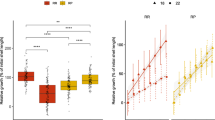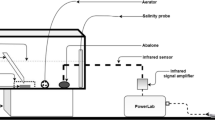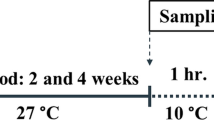Abstract
Recently, mass mortality affected the cultured small abalone, Haliotis diversicolor diversicolor, which was the dominant cultured abalone species in southern China. Prior studies revealed that survivorship varied significantly between different stocks and crosses. However, the immunological basis for differences in susceptibility has not been well understood to date. Herein, low temperature, air exposure tolerance tests, and pull-off force measurement were assessed in the three groups (Japan, Taiwan, and their Hybrid stock). The results showed that the critical thermal minimum (CTMin) at 50% was 15.6 °C for the Taiwan stock, 12.1 °C for the Japan stock, and 13.2 °C for the Hybrid stock. Upon air exposure challenge, 100% abalones from the Taiwan group died after 8 h at 24 °C, while the survival rate in the Japan and Hybrid groups were 37.8% and 29.4%, respectively. The detachment stress for the Japan group was 42.3 kPa, which was 2.78-fold and 1.43-fold higher compared to the Taiwan and Hybrid groups, respectively. Variation in susceptibility to disease may be based on the effectiveness of the innate immune responses. Therefore, total hemocyte count, phagocytosis, respiratory burst, superoxide dismutase activity, acid phosphatase activity, alkaline phosphatase activity, and myeloperoxidase activity were determined for the healthy abalones in each group. Positive mid-parent heterosis on immunological parameters was consistent with the prior knowledge on the positive mid-parent heterosis for survival rate, which indicated the improvement on immune reaction and disease resistance through hybridization methods. The current study will be useful in efficient design of breeding programs for the development of sustainable abalone aquaculture.





Similar content being viewed by others
Abbreviations
- CTMin:
-
Critical thermal minimum
- ROS:
-
Reactive oxygen species
- ACP:
-
Acid phosphatase
- ALP:
-
Alkaline phosphatase
- SOD:
-
Superoxide dismutase
- WLR:
-
Weight loss rate
- THC:
-
Total hemocyte count
- FL1 :
-
First fluorescence
- PP:
-
Phagocytic rate
- DCFH-DA:
-
2′,7′-Dichlorfluorescein diacetate
- DCFH:
-
Dichlorofluorescein
- DCF:
-
2′,7′-Dichlorofluorescein
- MPO:
-
Myeloperoxidase
- SDS:
-
Sodium-dodecyl sulfate
- H MP :
-
Mid-parent heterosis
- CTMax:
-
Critical thermal maximum
- CAT:
-
Catalase
References
Adema CM, Van der Knaap WPW, Siminia T (1991) Molluscan haemocyte-mediated cytotoxicity: the role of reactive oxygen intermediates. Rev Aquat Sci 4:201–223
Babior BM (1978) Oxygen-dependent microbial killing by phagocytes (first of two parts). N Engl J Med 298:659–668
Bachère E, Hervio D, Miahle E (1991) Luminol-dependant chemiluminescence by haemocytes of the two marine bivalves, Ostrea edulis and Crassostrea gigas. Dis Aquat Org 11:173–180
Bansemer MS, Harris JO, Qin JG, Adams LR, Duong DN, Stone DA (2006) Growth and feed utilisation of juvenile greenlip abalone (Haliotis laevigata) in response to water temperatures and increasing dietary protein levels. Aquaculture 436:13–20
Bass DA, Parce JW, Dechatelet LR, Szejda P, Seeds MC, Thomas M (1983) Flow cytometric studies of oxidative product formation by neutrophils: a graded response to membrane stimulation. J Immunol 130:1910–1917
Becker CD, Genoway RG (1979) Evaluation of the critical thermal maximum for determining thermal tolerance of freshwater fish. Environ Biol Fish 4(3):245–256
Buestel D, Ropert M, Prou J, Goulletquer P (2009) History, status, and future of oyster culture in France. J Shellfish Res 28(4):813–820
Cai W, Li S, Ma J (2004) Diseases resistance of Nile tilapia (Oreochromis niloticus), blue tilapia (Oreochromis aureus) and their hybrid (female Nile tilapia×male blue tilapia) to Aeromonas sobria. Aquaculture 229(1):79–87
Cai J, Han Y, Wang Z (2006) Isolation of Vibrio parahaemolyticus from abalone (Haliotis diversicolor supertexta L.) postlarvae associated with mass mortalities. Aquaculture 257(1):161–166
Cardinaud M, Offret C, Huchette S, Moraga D, Paillard C (2014) The impacts of handling and air exposure on immune parameters, gene expression, and susceptibility to vibriosis of European abalone Haliotis tuberculata. Fish Shellfish Immunol 36(1):1–8
Chang PH, Kuo ST, Lai SH, Yang HS, Ting YY, Hsu CL, Chen HC (2005) Herpes-like virus infection causing mortality of cultured abalone Haliotis diversicolor supertexta in Taiwan. Dis Aquat Org 65(1):23–27
Chang PH, Yang MC, Kuo ST, Chen MH, Cheng CH (2008) Occurrence of a rickettsia-like prokaryote in the small abalone, Haliotis diversicolor supertexta, cultured in Taiwan. Bull Eur Assoc Fish Pathol 28(2):52–57
Chen M, Yang H, Delaporte M, Zhao SJ, **ng K (2007) Immune responses of the scallop Chlamys farreri after air exposure to different temperatures. J Exp Mar Biol Ecol 345(1):52–60
Cheng W, Hsiao IS, Hsu CH, Chen JC (2004a) Change in water temperature on the immune response of Taiwan abalone Haliotis diversicolor supertexta and its susceptibility to Vibrio parahaemolyticus. Fish Shellfish Immunol 17:235–243
Cheng W, Hsiao IS, Chen JC (2004b) Effect of ammonia on the immune response of Taiwan abalone Haliotis diversicolor supertexta and its susceptibility to Vibrio parahaemolyticus. Fish Shellfish Immunol 17(3):193–202
Cheng W, Juang FM, Chen JC (2004c) The immune response of Taiwan abalone Haliotis diversicolor supertexta and its susceptibility to Vibrio parahaemolyticus at different salinity levels. Fish Shellfish Immunol 16:295–306
Cowles RB, Bogert CM (1944) A preliminary study of the thermal requirements of desert reptiles. Bull Am Mus Nat Hist 83(5):261–296
Deng Y, Liu X, Zhang G (2007) Fertilization, hatching, metamorphosis and growth oftwo Pacific abalone populations and their reciprocal crosses. Aquaculture 272:S319–S320
Denny MW (1984) Mechanical properties of pedal mucus and their consequences forgastropod structure and performance. Am Zool 24(1):23–36
Denny MW, Gosline JM (1980) The physical properties of the pedal mucus of theterrestrial slug, Ariolimax columbianus. J Exp Biol 88(1):375–394
Di G, Zhang Z, Ke C (2013) Phagocytosis and respiratory burst activity of haemocytes from the ivory snail, Babylonia areolata. Fish Shellfish Immunol 35(2):366–374
Di G, Kong X, Zhu G, Liu S, Zhang C, Ke C (2016) Pathology and physiology of Haliotis diversicolor, with withering syndrome. Aquaculture 453:1–9
Dı́az F, del Rı́o-Portı́lla MA, Sierra E, Aguilar M, Re-Araujo AD (2000) Preferred temperature and critical thermal maxima of red abalone Haliotis rufescens. J Therm Biol 25(3):257–261
Díaz F, Re AD, Medina Z, Re G, Valdez G, Valenzuela F (2006) Thermal preference and tolerance of green abalone Haliotis fulgens (Philippi, 1845) and pink abalone Haliotis corrugata (Gray, 1828). Aquac Res 37(9):877–884
Dweyer JJ, Burnett LE (1996) Acid-base status of the oyster Crassostrea virginica in response to air exposure and to infections by Perkinsus marinus. Biol Bull 190(1):139–147
Falconer DS, Mackay TFC (1996) Introduction to quantitative genetics, 4th edn. Longman Essex, England
Foley DA, Cheng TC (1975) A quantitative study of phagocytosis by hemolymph cells of the pelecypods Crassostrea virginica and Mecenaria mercenaria. J Invertebr Pathol 25:189–197
Ford T, Beitinger TL (2005) Temperature tolerance in the goldfish, Carassius auratus. J Therm Biol 30(2):147–152
Gilroy A, Edwards SJ (1998) Optimum temperature for growth of australian abalone: preferred temperature and critical thermal maximum for blacklip abalone Haliotis rubra (Leach), and greenlip abalone Haliotis laevigata (Leach). Aquac Res 29:481–485
Hahn KO (1989) Biotic and abiotic factors affecting the culture abalone. In: Hahn KO (ed) Handbook of culture of abalone and other marine gastropods. CRC Press, Boca Raton
He L, **n Z, Ying H, Yang H, Wang Y, Zhang Z (2017) The characterization of RHEB, gene and its responses to hypoxia and thermal stresses in the small abalone Haliotis diversicolor. Comp Biochem Physiol B Biochem Mol Biol 210:48–54
Hecht T (1994) Behavioural thermoregulation of the abalone Haliotis midae, and the implications for intensive culture. Aquaculture 26:171–181
Hégaret H, Wikfors GH, Soudant P (2003) Flow cytometric analysis of haemocytes from eastern oysters, Crassostrea virginica, subjected to a sudden temperature elevation: II. Haemocyte functions: aggregation, viability, phagocytosis, and respiratory burst. J Exp Mar Biol Ecol 293(2):249–265
Hooper C, Day R, Slocombe R, Handlinger J, Benkendorff K (2007) Stress and immune responses in abalone: limitations in current knowledge and investigative methods based on other models. Fish Shellfish Immunol 22(4):363–379
Hooper C, Day R, Slocombe R, Benkendorff K, Handlinger J, Goulias J (2014) Effects of severe heat stress on immune function, biochemistry and histopathology in farmed Australian abalone (hybrid Haliotis laevigata × Haliotis rubra). Aquaculture 432:26–37
Hsu TH, Gwo JC (2017) Genetic diversity and stock identification of small abalone (Haliotis diversicolor) in Taiwan and Japan. PLoS One 12(6):e0179818
Iwanaga S, Lee BL (2005) Recent advances in the innate immunity of invertebrate animals. BMB Rep 38(2):128–150
Jia X, Zhang Z, Wang S, Lin P, Zou ZH, Huang BQ, Wang YL (2009) Effects of tributyltin (TBT) on enzyme activity and oxidative stress in hepatopancreas and hemolymph of small abalone, Haliotis diversicolor supertexta. Chin J Oceanol Limnol 27:816–824
Knight JA (2000) Review: free radicals, antioxidants, and the immune system. Ann Clin Lab Sci 30:145–159
Kumazawa NH, Morimoto N, Okamoto Y (1993) Luminol-dependent chemilumin-escence of haemocytes derived from marine and estuarine mollusks. J Vet Med Sci 55:287–290
Lafarga de la Cruz F, Gallardo-Escárate C (2011) Intraspecies and interspecies hybrids in Haliotis: natural and experimental evidence and its impact on abalone aquaculture. Rev Aquac 3:74–99
Lamkey KR, Edwards JW (1999) The quantitative genetics of heterosis. In: JG Coors and S Pandey (eds) Proceedings of the International Symposium on the Genetics and Exploitation of Heterosis in Crops, CIMMYT. Mexico City, Mexico. Aug. 17–22, 1997. pp 31–48
Lee KK, Liu PC, Chen YC, Huang CY (2001) The implication of ambient temperature with outbreak of vibriosis in cultured small abalone Haliotis diversicolor supertexta Lischke. J Therm Biol 26:585–587
Leighton D, Lewis C (1983) Experimental hybridization in abalone. Invertebr Reprod Dev 5:273–282
Liang S, Luo X, You W, Luo X, Ke C (2014) The role of hybridization in improving the immune response and thermal tolerance of abalone. Fish Shellfish Immunol 39(1):69–77
Liang S, Luo X, You W, Luo X, Ke C (2018) Hybridization improved bacteria resistance in abalone: evidence from physiological and molecular responses. Fish Shellfish Immunol 72:679–689
Lin AYM, Brunner R, Chen PY, Talke FE, Meyers MA (2009) Underwater adhesion of abalone: the role of van der Waals and capillary forces. Acta Mater 57(14):4178–4185
Liu S, Mai K (2003) The progress of studies on molluscs immunological system and mechanism—a review. Acta Oceanol Sin 25:95–105
Liu X, Yan Y, Wang Z, Cai M, Ke C (2008) A preliminary study on tolerance to high temperature and low salinity of Haliotis diversicolor Reeve. J Jimei Univ Natur Sci 4:301–303
Livingstone DR (2001) Contaminant-stimulated reactive oxygen species production and oxidative damage in aquatic organisms. Mar Pollut Bull 42:656–666
Lv ZM, Yang AG, Wang QY, Liu ZH, Zhou LQ (2006) Preliminary cytological identification and immunological traits of hybrid scallop from Chlamys farreri (♀) × Patinopecten yessoensis (♂). J Fish Sci China 13(4):597–602
Marshall DJ, McQuaid CD (1993) Differential physiological and behavioural responses of the intertidal mussels, Choromytilus meridionalis (Kr.) and Perna perna L., to exposure to hypoxia and air: a basis for spatial separation. J Exp Mar Biol Ecol 171(2):225–237
Matozzo V, Ballarin L, Marin MG (2004) Exposure of the clam Tapes philippinarum to 4-nonylphenol: changes in anti-oxidant enzyme activities and re-burrowing capability. Mar Pollut Bull 48:563–571
Michaelidis B, Haas D, Grieshaber MK (2005) Extracellular and intracellular acid-base status with regard to the energy metabolism in the oyster Crassostrea gigas during exposure to air. Physiol Biochem Zool 78(3):373–383
Nie ZQ, Wang SP (2004) The status of abalone culture in China. J Shellfish Res 23(4):941–945
Ospina AF, Mora C (2004) Effect of body size on reef fish tolerance to extreme low and high temperatures. Environ Biol Fish 70(4):339–343
Paladino FV, Spotila JR, Schubauer JP, Kowalski KT (1980) The critical thermal maximum: a technique used to elucidate physiological stress and adaptation in fishes. Rev Can Biol 39(2):115–122
Park KI, Donaghy L, Kang HS, Hong HK, Kim YO, Choi KS (2012) Assessment of immune parameters of manila clam Ruditapes philippinarum in different physiological conditions using flow cytometry. Ocean Sci J 47(1):19–26
Pipe RK, Coles JA (1995) Environmental contaminants influencing immune function in marine bivalve molluscs. Fish Shellfish Immunol 5(8):581–595
Pipe RK, Coles JA, Thomas ME, Fossato VU, Pulsfor AL (1995) Evidence for environmentally derived immunomodulation in mussels from the Venice Lagoon. Aquat Toxicol 32(1):59–73
Rahman MF, Siddiqui MK (2004) Biochemical effects of vepacide (from Azadirachta indica) on Wistar rats during subchronic exposure. Ecotoxicol Environ Saf 59:332–339
Reynolds WW (1979) Perspective and introduction to the symposium: thermoregulation in ectotherms. Am Zool 19(1):193–194
Roch P (1999) Defense mechanisms and disease prevention in farmed marine invertebrates. Aquaculture 172(1):125–145
Rothe G, Valet G (1990) Flow cytometric analysis of respiratory burst activity in phagocytes with hydroethidine and 2′, 7′-dichlorofluorescin. J Leukocyte Boil 47(5):440–448
Soares-da-Silva IM, Ribeiro J, Valongo C, Pinto R, Vilanova M, Bleher R, Machado J (2002) Cytometric, morphologic and enzymatic characterisation of haemocytes in Anodonta cygnea. Comp Biochem Phys A 132(3):541–553
Song ZR, Ji RX, Yan SF, Chen CS, Zhong YP, Jiang YH, Ni ZM (2000) A spherovirus resulted in mass mortality of Haliotis diversicolor aquatilis. J Fisheries China 24(5):463–467
Wang SH, Wang YL, Zhang ZX (2004) Different response of innate immune factors in abalone Haliotis diversicolor supertexta to E. coli or Vibrio parahaemolyticus infection. J Shellfish Res 23:1173–1177
Wells RMG, Baldwin J (1995) A comparison of metabolic stress during air exposure in two species of New Zealand abalone, Haliotis iris and Haliotis australis: implications for the handling and ship** of live animals. Aquaculture 134(3):361–370
Xue QG, Renault T, Chilmonczyk S (2001) Flow cytometric assessment of haemocyte sub-populations in the European flat oyster, Ostrea edulis, haemolymph. Fish Shellfish Immunol 11:557–567
Yakovleva NV, Samoilovich MP, Gorbushin AM (2001) The diversity of strategies of defense from pathogens in molluscs. J Evol Biochem Physiol 37:358–367
Yang C, Kong J, Wang Q, Liu QH, Tian Y, Luo K (2007) Heterosis of haemolymph analytes of two geographic populations in Chinese shrimp Fenneropenaeus chinensis. Fish Shellfish Immunol 23(1):62–70
You WW, Ke CH, Luo X, Wang DX (2009) Growth and survival of three small abalone Haliotis diversicolor populations and their reciprocal crosses. Aquac Res 40(13):1474–1480
You WW, Luo X, Wang DX, Lin ZB, Lin HY, Ke CH (2010) Comparisons of morphological characteristics and grow-out performance in new variety Dongyou No. 1 and its parental populations of small abalone Haliotis diversicolor. J Fisheries China 12:1837–1843
You WW, Lin HY, Luo X, Wang DX, Lin ZB, Ke CH (2011a) Effects of temperature on the growth rates and survival rates of Haliotis diversicolor among different populations. J Oceanography Taiwan Strait 30(4):583–588
You WW, Zhan X, Wang DX, Li WD, Luo X, Ke CH (2011b) Genetic variation analysis in wild and cultured subpopulations of small abalone Haliotis diversicolor estimated by microsatellite markers. N Am J Aquac 73(4):445–450
Yu RH, Wang ZP, Kong LF, Li Q, Zheng XD (2006) A study on the survival rate of Pacific oysters in different exposure states at different development stages. J Ocean Univ China 36(4):617–620
Zhang GF, Que HY, Liu X, Xu HS (2004) Abalone mariculture in China. J Shellfish Res 23(4):947–950
Zheng HP, Zhang GF, Guo XM, Liu X (2006) Heterosis between two stocks of the bay scallop, Argopecten irradians irradians Lamarck. J Shellfish Res 25:807–812
Funding
This work was supported by grants from National Natural Science Foundation of China (No. 31472277, U1605213), Key S&T Program of Fujian & Shandong Province (No. 2016NZ01010006 and 2016GGH4513), and Earmarked Fund for Modern Agro-industry Technology Research System (No. CARS-49).
Author information
Authors and Affiliations
Corresponding author
Rights and permissions
About this article
Cite this article
You, W., Wang, B., Luo, X. et al. Environmental stress tolerance and immune response for the small abalone hybrids. Aquacult Int 27, 105–123 (2019). https://doi.org/10.1007/s10499-018-0310-y
Received:
Accepted:
Published:
Issue Date:
DOI: https://doi.org/10.1007/s10499-018-0310-y




